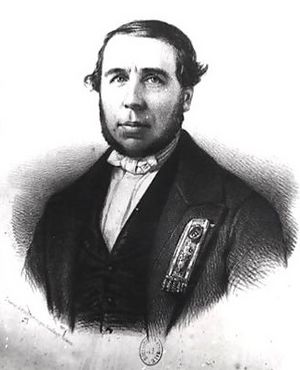Benoît Fourneyron facts for kids
Quick facts for kids
Benoît Fourneyron
|
|
|---|---|

Benoît Fourneyron
|
|
| Born | 31 October 1802 Saint-Étienne, Loire, France
|
| Died | 31 July 1867 (aged 64) |
| Nationality | French |
| Education | École Nationale Supérieure des Mines de Saint-Étienne |
| Occupation | Engineer |
| Engineering career | |
| Projects | water turbine |
Benoît Fourneyron (born October 31, 1802 – died July 31, 1867) was a clever French engineer. He was born in a town called Saint-Étienne, in France. Benoît Fourneyron is famous for helping to create and improve water turbines. These machines use the power of moving water to create energy.
Benoît went to a special engineering school called the École Nationale Supérieure des Mines de Saint-Étienne. It was a new school near his home. After finishing his studies in 1816, he worked in mines and places where ironwork was done. Around this time, many French engineers, including some of his old teachers, were trying to make old machines like the waterwheel better. They used new math and science ideas to do this.
For hundreds of years, waterwheels had used the energy from rivers and streams. They mostly helped to grind grain into flour. But new machines from the Industrial Revolution needed much more power. By the 1820s, everyone wanted to make waterwheels work even better.
What is a Water Turbine?
A water turbine is like a very advanced waterwheel. It uses the force of flowing water to spin a set of blades. This spinning motion then creates power. Turbines are much more efficient than old waterwheels. They can get a lot more energy from the same amount of water.
Fourneyron's Amazing Turbines
In 1827, when he was just 25, Fourneyron built his first "turbine." He got the idea from one of his former teachers, Claude Burdin. The word "turbine" comes from a Greek word meaning "whirling" or "vortex."
Unlike traditional waterwheels that stood upright, Fourneyron's turbine lay flat. It had two sets of curved blades. These blades were shaped to catch the water's movement in the best way possible. This design helped the turbine get as much power as it could from the water. His first turbine produced about 6 horsepower. Fourneyron even won a 6,000 franc prize for creating the first successful commercial water turbine!
Over the next ten years, Fourneyron kept building bigger and better turbines. He learned from every new model he made. By 1837, he had created a turbine that could produce 60 horsepower. This machine was incredibly fast, spinning 2,300 times every minute! The turbine's wheel was only one foot wide and weighed just 40 pounds. It was also very efficient, using 80% of the water's energy.
Turbines Around the World
Soon, hundreds of factories started using Fourneyron's turbine design. Other countries also began using his ideas to power their machines. His turbines became very popular in Europe and the United States. They were especially important for the textile factories in New England.
Later, in 1895, Fourneyron-style turbines were installed at Niagara Falls in the U.S. These powerful turbines helped to create electric power for many homes and businesses.
In 1861, Benoît Fourneyron was honored by the American Academy of Arts and Sciences. He was made an honorary member for his important work.
See also
 In Spanish: Benoît Fourneyron para niños
In Spanish: Benoît Fourneyron para niños
- Water Turbine timeline
- Cavan Water Mill

